Choosing Arabians for Sport is a case by case situation. There are two issues to me and the first has been mentioned they are bred today to stand in a semi parked stanse to have the illusion of a flat top line but infact they are taller behind than at the withers and worse they are taller at the base of the tail than the hip with a very high neck. This makes them have a very hard time relaxing their back and lifting their back. The other thing that has deteriorated severely is the canter and gallop. They canter and gallop inverted and sprong off their legs with little bending of the joints. You can look at a lot of terrible canters before you find one that could do dressage and flourish. It is hard to find them too because the deliberately encourage and video these horrible canters. I would look at horses who have had success with western divisions I guess. PatO
,
That list is problematic in many ways. It doesn’t consider percentage of offspring doing well in dressage, the influence of the dam side is completely overlooked, open results are not fully incorporated, and low level wins count as much as FEI level (though they did single out those that had FEI offspring).
I get the impression (having been away for a while) that dressage has kind of been the red headed stepchild of the Arab world until recently. So I do believe that people have selected horses for their individual merits rather than pedigrees to some extent. The list just shows how the pedigrees of those individuals happened to work out. In the article they say “Serendipity has likely played a role in how many offspring found the perhaps unintended consequence of a dressage career.” But it’s clear that serendipity or not, some lines are good performers in dressage. They don’t delve into why too much in the article.
Finally, I didn’t mean to slight Egyptians. Just stating that they don’t appear on the list, for whatever reason. That being said, KB Omega Fahim, the current GP Sport Horse Nationals champion, appears to be straight, or very high percentage Egyptian (sorry, my bloodline reading skills are a bit rusty). I’m sure others with Egyptian lines are just as capable.
Historically, while purpose breeding Arabians for dressage has been sporadic, there have been breeders who did so including Gina Manion of Manion Canyon (with heavy Raffles CMK lines) and Gail Hoff-Carmona (with Eqyptian lines, btw) among many others who were mostly under the radar. Prior to the elevation of the “show” Arab as the epitome of the breed and the explosion in the number of Arabians in the US (and Europe), Arabians were often used for dressage as well as for fox-hunting, jumping, and eventing. Notably, Arabians are one breed where individuals have been trained to the classical airs. (The also often maligned American Saddlebred is another such breed. gasp!)
As someone who came to Arabians after more than a decade with Warmbloods (Dutch, Hanos, and Traks), I was attracted to a certain phenotype within the Arabian breed. I like the big bodied Arabs with substance and with three correct gaits.
As I delved into researching performance in dressage and pedigrees, I did discover a few lines that seemed to appear with greater frequency in upper level horses than other lines.
The combination of Oran with Rissalix is found in horses like The Count of Al-Marah who was trained to the airs by the great Ward Wells, Bright Meadows who Chuck Grant thought was a contender for the 1976 US Olympic team, Golden Wings who represented the UK in FEI competitions, Silent Fire who was trained to GP, the great broodmare Silent Wings who had a number of good dressage and jumper descendants, and Magic Domino AHS who was bred in the UK then exported to Canada where he was approved by the Canadian Trakehener Association prior to being sold to the US where he has competed in dressage and sired a number of offspring that are doing well in dressage.
Oran is also a highly influential pedigree element of the deceased Anglo-Arab, Fairlyn Gemini, whose sire was by Oran and whose dam was an Oran granddaughter. Fairlyn Gemini was Trak approved and lifetime approved with the Sport Horse Breeding of Great Britain.
When I decided to start breeding I sought out horses with a sport horse phenotype that traced to Oran and/or Rissalix as well as other lines like certain branches of the Raffles line and the Aurab/Aulrab line that were complimentary and also known to produce dressage or other sport type horses.
Oran contributed great freedom in the shoulder as well as an overall structural strength to many of his descendants. He’s also known for contributing height sometimes to 16H–and not from long canons or long upright shoulders as can be the case with some “tall” Arabians.
Rissalix is known for producing expressive trots. The "right"Raffles lines will add 4-square balance among other athletic qualities. Aulrab gives substance, height, and elastic powerful gaits. Each of these lines also has faults that can appear so selecting breeding matches to optimize the good traits ad minimize the chances for functional faults to crop up is essential. Finding breeders who KNOW the lines and will share their insights is really helpful.
IMO, as is true with any breed, selecting horses that have been purpose bred for athleticism and rideability over generations with known close relatives with demonstrated dressage ability will have a higher chance of producing offspring with dressage ability than using horses that have not been consistently bred over generations for those traits. Sure serendipity can play a hand to produce an unexpected success, but the crap shoot of breeding always benefits from loading the dice. YMMV.
the photos below are
Oran; The Count of Al-marah; Dancing Diamond (Arab granddam of Fairlyn Gemini); Anglo-Arab Fairlyn Gemini; and FCF Enchanted Flame a 2009 colt with multiple lines to Oran and Rissalix as a yearling
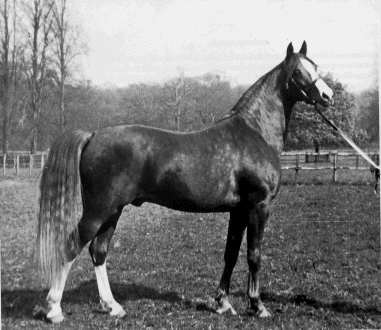
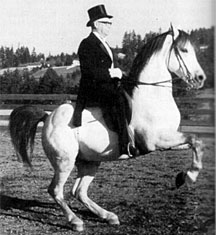
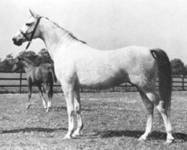
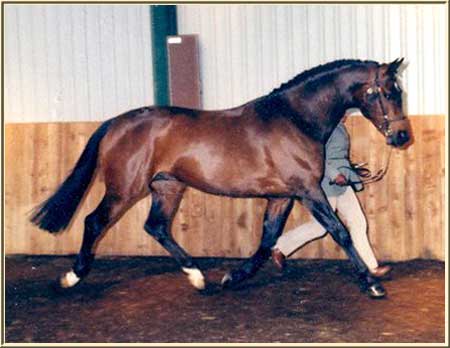
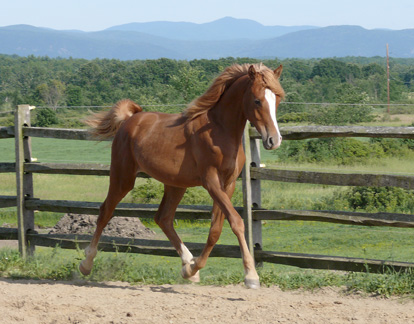
One of my bugaboos is the tight backs with the associated poor canters. There are more reasons for the tight backs than just those that are built down hill with poorly angled hindquarters. There are some Arabians that have rather correct conformation (correct for sport) that still move with a great deal of tension in their topline. Training can overcome this to some degree, but when you can find the ones that prefer to adopt a dorsoflexed carriage with a swinging back rather than an inverted carriage with a tight topline then you are ahead of the game.
Endurance lines, racing lines, and working western (cutting and reining) lines as well as those purpose bred for any of the sport disciplines are more likely to have good canters and to be relatively easy to encourage to use their bodies with elastic engagement than many of the popular modern show lines.
IMO, as more Arabian folks learn about the sport disciplines and try to breed for them, there will be an increase in Arabians that are suitable as really good dressage horses. Time will tell.
[QUOTE=columbus;5498969]
Choosing Arabians for Sport is a case by case situation. There are two issues to me and the first has been mentioned they are bred today to stand in a semi parked stanse to have the illusion of a flat top line but infact they are taller behind than at the withers and worse they are taller at the base of the tail than the hip with a very high neck. This makes them have a very hard time relaxing their back and lifting their back. The other thing that has deteriorated severely is the canter and gallop. They canter and gallop inverted and sprong off their legs with little bending of the joints. You can look at a lot of terrible canters before you find one that could do dressage and flourish. It is hard to find them too because the deliberately encourage and video these horrible canters. I would look at horses who have had success with western divisions I guess. PatO[/QUOTE]
This whole paragraph deals only with the Arabians used in Halter showing, not bred for sport.
[QUOTE=App’nover;5497637]
I would agree with starting with some of the approved lines by the warmblood associations and peruse the Sporthorse Nationals Payback program stallions, many of which are actively showing dressage.[/QUOTE]
An article on Khemosabi’s influence in sport is also due for release by SHN Payback the end of the month. (The writer has a brother living in Japan, so it may be delayed slightly). It includes an interview with Paul Husband (owner of Khemosabi). Sign up for the mailing list if you want a copy.
